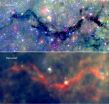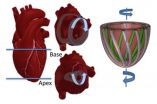(Press-News.org) New images from the Smithsonian's Submillimeter Array (SMA) telescope provide the most detailed view yet of stellar nurseries within the Snake nebula. These images offer new insights into how cosmic seeds can grow into massive stars.
Stretching across almost 100 light-years of space, the Snake nebula is located about 11,700 light-years from Earth in the direction of the constellation Ophiuchus. In images from NASA's Spitzer Space Telescope it appears as a sinuous, dark tendril against the starry background. It was targeted because it shows the potential to form many massive stars (stars heavier than 8 times our Sun).
"To learn how stars form, we have to catch them in their earliest phases, while they're still deeply embedded in clouds of gas and dust, and the SMA is an excellent telescope to do so," explained lead author Ke Wang of the European Southern Observatory (ESO), who started the research as a predoctoral fellow at the Harvard-Smithsonian Center for Astrophysics (CfA).
The team studied two specific spots within the Snake nebula, designated P1 and P6. Within those two regions they detected a total of 23 cosmic "seeds" - faintly glowing spots that will eventually birth one or a few stars. The seeds generally weigh between 5 and 25 times the mass of the Sun, and each spans only a few thousand astronomical units (the average Earth-Sun distance). The sensitive, high-resolution SMA images not only unveil the small seeds, but also differentiate them in age.
Previous theories proposed that high-mass stars form within very massive, isolated "cores" weighing at least 100 times the mass of the Sun. These new results show that that is not the case. The data also demonstrate that massive stars aren't born alone but in groups.
"High-mass stars form in villages," said co-author Qizhou Zhang of the CfA. "It's a family affair."
The team also was surprised to find that these two nebular patches had fragmented into individual star seeds so early in the star formation process.
They detected bipolar outflows and other signs of active, ongoing star formation. Eventually, the Snake nebula will dissolve and shine as a chain of several star clusters.
INFORMATION: END
SMA unveils how small cosmic seeds grow into big stars
2014-02-26
ELSE PRESS RELEASES FROM THIS DATE:
Follow-up care for older breast cancer survivors needs to be all-encompassing
2014-02-26
Older women who have overcome breast cancer are likely to struggle with heart disease, osteoporosis and hypertension further on in their lives. Whether these conditions occur or not is influenced by the treatment that patients received to fight cancer, their overall weight and their age. Breast cancer survivors therefore should watch their weight and get regular exercise so that they can enjoy a high quality of life. These findings, by lead author Nadia Obi of the University Medical Center Hamburg-Eppendorf, who collaborated with the group of Prof. Chang-Claude from the ...
New research indicates causal link between vitamin D, serotonin synthesis and autism
2014-02-26
February 26, 2014 - Oakland, CA – A new study by Rhonda Patrick, PhD and Bruce Ames, PhD of Children's Hospital Oakland Research Institute (CHORI) demonstrates the impact that Vitamin D may have on social behavior associated with Autism Spectrum Disorder (ASD). Dr. Patrick and Dr. Ames show that serotonin, oxytocin, and vasopressin, three brain hormones that affect social behavior, are all activated by vitamin D hormone. Autism, which is characterized by abnormal social behavior, has previously been linked to low levels of serotonin in the brain and to low vitamin D levels, ...
Beaumont study: Gamma Knife helps patients with painful facial nerve disorder
2014-02-26
Research by Beaumont Health System radiation oncologists and neurosurgeons found that symptoms of trigeminal neuralgia, or TN, a nerve disorder causing severe facial pain, were reduced in those treated with Gamma Knife stereotactic radiosurgery. The results were published in the February issue of the journal Clinical Neurology and Neurosurgery.
TN is a disorder of the trigeminal nerve, which is responsible for feeling in the face. In most cases, the facial pain is caused by a blood vessel pressing on the nerve. It is believed that TN is caused by deterioration of the ...
Reproductive coercion, intimate partner violence prevalent
2014-02-26
Enough women experience reproductive coercion – male behavior to control contraception and pregnancy outcomes – that a research team now recommends health care providers address the subjects with their patients and tailor family planning discussions and recommendations accordingly.
Researchers from Women & Infants Hospital of Rhode Island were part of a team that published "Reproductive coercion and co-occurring intimate partner violence in obstetrics and gynecology patients" in a recent issue of the American Journal of Obstetrics and Gynecology.
"Reproductive coercion, ...
Artificial muscles that do the twist
2014-02-26
In the heart, as in the movies, 3D action beats the 2D experience hands down.
In 3D, healthy hearts do their own version of the twist. Rather than a simple pumping action, they circulate blood as if they were wringing a towel. The bottom of the heart twists as it contracts in a counterclockwise direction while the top twists clockwise. Scientists call this the left ventricular twist—and it can be used as an indicator of heart health.
The heart is not alone. The human body is replete with examples of soft muscular systems that bend, twist, extend, and flex in complex ...
Superabsorbing design may lower manufacturing cost of thin film solar cells
2014-02-26
Researchers from North Carolina State University have developed a "superabsorbing" design that may significantly improve the light absorption efficiency of thin film solar cells and drive down manufacturing costs.
The superabsorbing design could decrease the thickness of the semiconductor materials used in thin film solar cells by more than one order of magnitude without compromising the capability of solar light absorption.
"State-of-the-art thin film solar cells require an amorphous silicon layer that is about 100 nanometers (nm) thick to capture the majority of the ...
A cavity that you want
2014-02-26
BUFFALO, N.Y. – Associated with unhappy visits to the dentist, "cavity" means something else in the branch of physics known as optics.
Put simply, an optical cavity is an arrangement of mirrors that allows beams of light to circulate in closed paths. These cavities help us build things like lasers and optical fibers used for communications.
Now, an international research team pushed the concept further by developing an optical "nanocavity" that boosts the amount of light that ultrathin semiconductors absorb. The advancement could lead to, among other things, more powerful ...
Thirty-nine new species of endemic cockroach discovered in the southwestern US and Mexico
2014-02-26
A genus of cockroach in the poorly studied family Corydiidae has been revised for the first time since 1920. The revision has resulted in the discovery and description of 39 new species of Arenivaga, a genus which previously held nine species. The Corydiidae family of roaches is found worldwide and its constituents are frequently found in harsh, dry habitats not usually associated with cockroaches. They are also often subterranean in their habits making their presence easily overlooked.
The study was completed over a four-year period by Heidi Hopkins, who is a cockroach ...
Personalized medicine has finally arrived -- or has it?
2014-02-26
As the price for decoding a person's DNA keeps dropping, expectations for personalized medicine based on specific genetic profiling rise. But translating an individual's genetic data into finely tailored medical treatments still faces major challenges, explains a new article in Chemical & Engineering News (C&EN), the weekly magazine of the American Chemical Society.
Rick Mullin, senior editor at C&EN, notes that advances in DNA sequencing have allowed researchers to design some therapies, particularly in the cancer realm, for patients with certain genetic traits. As the ...
Decline of Bronze Age 'megacities' linked to climate change
2014-02-26
Scientists from the University of Cambridge have demonstrated that an abrupt weakening of the summer monsoon affected northwest India 4,100 years ago. The resulting drought coincided with the beginning of the decline of the metropolis-building Indus Civilisation, which spanned present-day Pakistan and India, suggesting that climate change could be why many of the major cities of the civilisation were abandoned.
The research, reported online on 25 February, 2014, in the journal Geology, involved the collection of snail shells preserved in the sediments of an ancient lake ...







